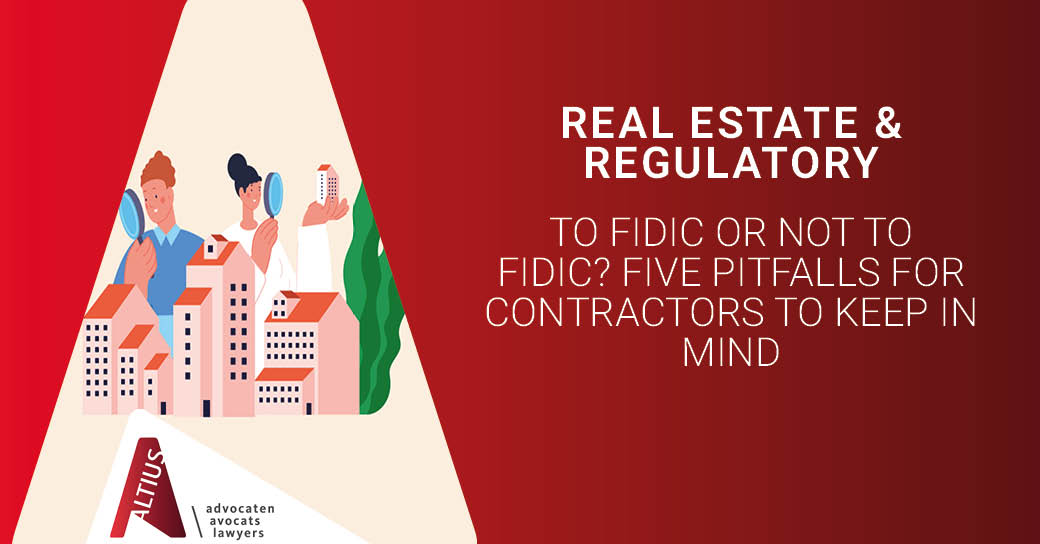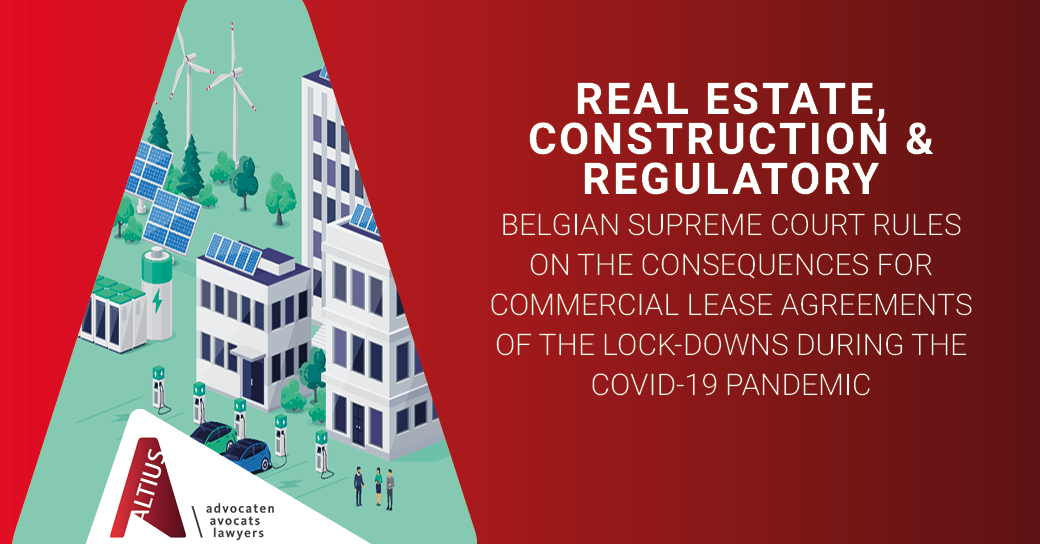To FIDIC or not to FIDIC? Five pitfalls for contractors to keep in mind

Working on an offshore wind power project in the Atlantic Ocean for the Japanese government but headquartered in Belgium? Flying over from Russia to construct Belgian railways by order of a French company?
In a globalised world, the construction industry is increasingly choosing FIDICs over national contractor agreements when it comes to negotiating about and formalising infrastructure projects. Are FIDICs really to be preferred above domestic contractor agreements?
Here are five pitfalls that contractors should be aware of whenever they are confronted with a FIDIC contract:
#1: FIDICs are a format
The word ‘FIDIC’ (Fédération Internationale des Ingénieurs-Conseils) comes from the name of the International Federation of National Member Associations of Engineers, which has issued a rainbow of standard forms of contractor agreements. The Red, Yellow and Silver Books are, to name a few examples, some commonly used forms for a particular type of structure.
Basically, each book is a FIDIC form with its own general conditions and its accompanying forms attached. For instance, the FIDIC Yellow Book is tailored to building and engineering works in which the contractor has designed the works and the engineer administers the contract.
However, there is no obligation to use FIDICs in a construction project with a cross-border nature. FIDICs are just a format. They are not required by law and not legally binding. No penalty applies in the event of the non-respect or non-application of FIDICs.
#2: The engineer and employer are protagonists
In most FIDIC settings, the engineer and employer fulfill a clear, specific, essential role. The employer, who is usually a public entity, acts as the client for whom an infrastructure project is to be constructed. The engineer acts on behalf of the employer and is in most FIDIC settings appointed and paid by the employer. While the engineer acts on behalf of the employer, if there are any claims or disputes before the Dispute Adjudication Board (DAB) then the engineer must act in a neutral and impartial way. Obviously, the engineer has been assigned a somewhat dubious role.
In contrast to a Belgian private law contractor agreement between a contractor and the client, a FIDIC clearly presumes a triad setting between the contractor, the employer and the engineer. Additionally, the general conditions of most FIDIC forms are conceived for the benefit of both the employer and engineer as they are inspired by the idea that the ‘unsavvy employer’ needs to be protected against the ‘malicious contractor’.
A tripartite structure most likely implies more internal discussions and thus more difficulties in reaching an agreement. Such a setting could especially become complicated if also many subcontractors are involved with a project. Those subcontractors are on a back-to-back basis bound by some higher-level FIDIC provisions and therefore limited in their contractual freedom with the contractor.
#3: Sequence of delivery and acceptance of works to be determined
For international and complex infrastructure projects, it is highly recommended to include in the contractor agreement a sequence of completion, phased delivery and acceptance since such a sequence is neither determined by Belgian construction law nor by the Red Book. The Yellow Book and Silver Book do elaborate on such a sequence as these books assign more design responsibility to the contractor.
Delivery of the works implies that upon completion of the works they are ready to be commissioned or used by the employer. Delivery is in FIDIC terms usually equal to the employer’s taking-over through issuing a taking-over certificate containing remarks and items that need to be remedied during the defects notification period.
The defects notification period covers at least one year in which the contractor can remedy the defects that have become visible during this period. However, this term could be extended or shortened (through particular conditions). The one-year term could also be extended by a maximum of two years if the employer did not have the opportunity to commission the works at all due to the many defects to be remedied.
Upon expiry of the defects notification period, the engineer or the employer confirms the acceptance of the works by issuing a performance certificate. Acceptance of the works implies that the employer acknowledges that the contractor has duly carried out the works.
#4: When does the contractor’s liability for major structural defects start?
Acceptance of the works not only releases the contractor of its obligations. Under Articles 1792 and 2270 of the Belgian Civil Code, it is also the starting point of the contractor’s ten-year liability period for major structural defects. Such defects must be that serious as to impair or be likely to impair the structure and robustness of the construction or a part of it. The contractor’s decennial liability is a rule of Belgian public order.
If construction works take place in Belgium but the contractor agreement is governed by foreign law, then the contractor’s ten-year liability is considered to be a rule of international public order under Article 9 of the Rome I-Regulation (EG) no. 593/2008 of the European Parliament and the Council of 17 June 2008 on the law applicable to contractual obligations, exactly because the decennial liability envisages protecting not only the client, but also public security.
Any non-respect of the decennial liability leads automatically to the absolute nullity of the clause in question. Therefore, any contractual exemption, exoneration or extension of the decennial liability is absolutely void, as well as any shortening, suspension or extension by either party of the ten-year period.
Do explicitly provide in the particular conditions of a FIDIC form:
- When acceptance of the works shall take place and therefore, whether the decennial liability period starts from the issuing of the taking-over certificate or from the issuing of the performance certificate.
#5: Is the contractor liable for minor hidden defects?
Defects that neither affect nor could potentially affect the stability or strength of the construction or a part of it are considered to be minor hidden defects.
The contractor’s liability period is also here ten years under Article 2262bis of the Belgian Civil Code. However, as this provision is one of complementary law, it is possible for the parties to shorten, extend, or even delete such a term on the condition that any limitation of liability is not due to the contractor’s intentional fault or fraud and that contractual obligations are neither deprived nor withdrawn from their true meaning as a consequence.
We again encourage explicitly stating in the particular conditions of a FIDIC form:
- Whether the contractor is liable for minor hidden defects.
- If yes, whether the contractor’s liability period for minor hidden defects starts from the issuing of the taking-over certificate or from the issuing of the performance certificate.
- If yes, how long the contractor’s liability period will be.
Bringing it all together:
The apparent great advantage of the FIDIC forms as international standards for the construction industry is at the same time their biggest flaw: since FIDIC is only a format, the parties still need to link back to the applicable mandatory provisions and rules of public order and adjust the FIDIC contract with them, which is time-consuming. In practice, the general conditions of a FIDIC contract are amended and completed in such a way via particular conditions that at the end of the project often only little remains of the FIDIC standard. Therefore, one can ask to what extent the FIDIC form has succeeded in adapting to local construction practices.
Written by
Recommended articles
Belgium aims for hospitals to increase their biosimilars uptake
Despite many initiatives by the (former) Minister of Health, the uptake of biosimilars in Belgium has remained rather low. In this blog, we summarise the new rules, which apply since 2 October 2023.
Read onBelgian Supreme Court rules on the consequences for commercial lease agreements of the lock-downs during the COVID-19 pandemic
The Supreme Court (“Hof van Cassatie/Court of Cassation”) overruled on 26 May 2023 a decision that determined that Article 1722 (old) Civil Code (a partial or total “destruction” of the leased premises) does not apply for the tenant that can not operate its premises due to the measures taken by the Belgian Government in order to prevent the spread of the COVID-19 pandemic.
Read onHow to challenge an award decision in Belgium
Public procurement is all about tendering. And tendering is about winning and… losing. Often, in-house lawyers need urgent advice on how to challenge award decisions. Here are some tips and tricks.
Read on


